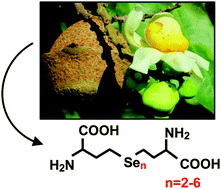The relationship of selenium tolerance and speciation in Lecythidaceae species†
Abstract
Comparative study of selenium (Se) speciation in hyperaccumulator plants offers an interesting challenge from the analytical point of view. In our study the application of a sophisticated sample clean-up procedure and the combination of elemental and molecular mass spectrometric methods led to the identification of several new selenocompounds. The difference between the Se speciation of the primary accumulator Lecythis minor and the secondary accumulator Bertholletia excelsa confirmed the current opinion that the speciation pattern in hyperaccumulator plants is principally related to the mechanism of accumulation and not to taxonomy. The most abundant new selenocompounds were found to be the derivatives of selenohomocysteine (SeHCy) and selenomethionine (SeMet), including fatty acid metabolism related compounds. A series of SeHCy derived species containing multiple Se atoms (>2) was also detected and their structures were validated by the synthesis of their S–Se analogues.


 Please wait while we load your content...
Please wait while we load your content...